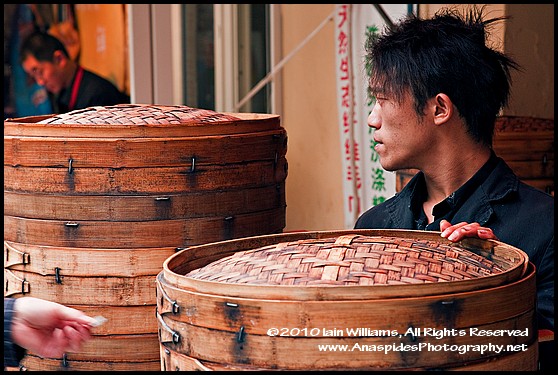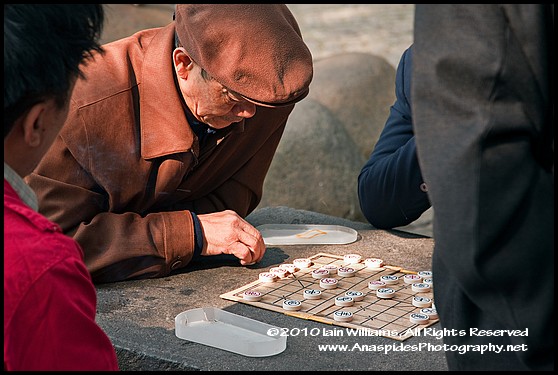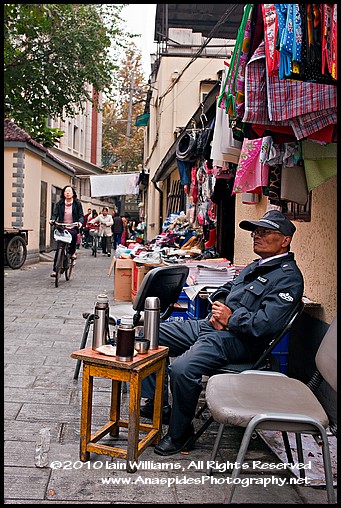Chinese Dichotomies, People's Republic of China
 Thursday, December 16, 2010 at 7:09PM
Thursday, December 16, 2010 at 7:09PM  Shanghai is the dichotomy between the old and the new. Whilst the central city district argues for space to develop and construct modern, tall skyscrapers and strives to match or better the aesthetics of a western city, Shanghai’s outer regions provide a glimpse into everyday Chinese city life.
Shanghai is the dichotomy between the old and the new. Whilst the central city district argues for space to develop and construct modern, tall skyscrapers and strives to match or better the aesthetics of a western city, Shanghai’s outer regions provide a glimpse into everyday Chinese city life.
LEFT: The new and the old. Modern skyscrapers loom over basic style accommodation.
Within a 5 minute taxi ride or underground tube ride from the central city you can discover an underworld vastly different to flash and glitz of the city central. The outer city is networked with main streets, many lined with evergreen trees, and most busy with taxis, cars, bicycles, and motor scooters. Shops fronts are almost endless and thriving sidewalk businesses common.
I noted an old man who had established a locksmith business on the sidewalk; his tools were old as was his desk, but there was a constant stream of business coming his way. Further along an old lady was busy repairing sheets with an ancient sewing machine. The repaired sheets were hung for inspection and collection from the electrical posts along the street. Further along the sidewalk a more modern business had evolved and a man was busy selling the latest releases of Hollywood movies.
It’s off these streets that you can wander along a seamlessly endless maze of smaller streets and alleys which lead to accommodation blocks, smaller businesses and street-side markets from which a dazzling variety of products are sold from plastic cups to live prawns and fish.
 I discovered a meat market along one of the alleys in which the remains of a poor animal were being unceremoniously cut into slabs of beef for the vendors to sell. A large tree stump was the cutting board and several sharp knives were being used to fleece the meat into manageable pieces.
I discovered a meat market along one of the alleys in which the remains of a poor animal were being unceremoniously cut into slabs of beef for the vendors to sell. A large tree stump was the cutting board and several sharp knives were being used to fleece the meat into manageable pieces.
LEFT: Dumplings are the mainstay of Chinese take away cuisine and can incorporate almost anything! The dumplings are steamed in large bamboo containers before being offered for sale.
Along another alley I came across a throng of people all arguing and yelling as they purchased their daily supply of seafood; live prawns were held captive in small red plastic buckets whilst small fish and fresh water eels  splashed about in tubs tantamount to freshness. Although I strongly disagree with the process of keeping captive animals in pitiful conditions to sell, I realize that what I am witnessing is a vibrant society little changed for hundreds of years. I walked to end of the alley and returned to the seafood market 30 minutes later only to find that the frenzy of activity had been short-lived, the people were gone and all that remained were some scales and fishy innards on the footpath! It was as if an illegal activity had occurred and the culprits had scampered after the deals had been completed!
splashed about in tubs tantamount to freshness. Although I strongly disagree with the process of keeping captive animals in pitiful conditions to sell, I realize that what I am witnessing is a vibrant society little changed for hundreds of years. I walked to end of the alley and returned to the seafood market 30 minutes later only to find that the frenzy of activity had been short-lived, the people were gone and all that remained were some scales and fishy innards on the footpath! It was as if an illegal activity had occurred and the culprits had scampered after the deals had been completed!
LEFT: Old Shanghai is mostly made from wood. Despite the maze of alleys in the back streets, signage was prominent indicating street names and house numbers.
Although accommodation blocks are very obvious, with their collection of washing hanging out to dry, hidden around these cement monstrosities are the remains of Shanghai little changed from 80 years ago. Narrow cement lined streets, not wide enough for a car lead to simple adjoined wooden structures with roofs tiled in shingles, wood or metal sheet. These dwellings literally sit in the shadow of tall modern buildings. The only resemblance of modern convenience is the satellite dish or television antennae.
 Parks and Gardens
Parks and Gardens
As can be expected China is noisy, however, streets in which accommodation blocks are located are relatively quiet, despite the network of busy and noisy streets surrounding them. I had bought a fruit bun in a busy street before turning along a side road to almost complete silence. I was about to consume my purchase on the street when I noticed a sign that said “park”.
LEFT: An elderly man immersed in the ancient game of mahjong fails to notice as a foreigner points a camera lens in his direction. Parks and gardens in China are people orientated and act as a respite from the noise and hype of modern Chinese life.
Before you could enter he park you had to peruse the rules which were written in both Chinese and in Chinese English. I dully noted that roller blades and roller skates were prohibited as was food. However, you were invited to dine in fine cuisine at the restaurant adjoining the park.
Finishing my fruit bun (outside the park) I entered to find a small girl playing on roller skates!
It soon became apparent that Chinese municipal parks do not have a western equivalent. A rough cement path leads toward an area where elderly people are sitting playing mahjong – a board game as ancient as China itself, before winding its way amongst dust and pollution covered shrubs and a few trees to an area where Ti Chi can be undertaken. Ti Chi is seems to be practiced by everyone in China, and as such special areas are often set aside to practice this oriental form of relaxation.
 Adjacent to the Tie Chi section of the park are numerous exercise machines available for public use in addition to a number of old wooden benches. Tired from wandering back alleys I decide to sit on a bench and observe Chinese daily life – at least amongst the elderly. Interestingly, the sound of traffic had subsided, and I wondered if the thick cement walls surrounding the small park was the reason; I could even here the sound of a few cheerful birds whose chirping had become very obvious by their earlier absence. Soon after, a loud electric saw intervened in the silence and looking toward the sound, I saw beside the park wall an industrious fellow busily making coffins. The Chinese work and work as long as they make money!
Adjacent to the Tie Chi section of the park are numerous exercise machines available for public use in addition to a number of old wooden benches. Tired from wandering back alleys I decide to sit on a bench and observe Chinese daily life – at least amongst the elderly. Interestingly, the sound of traffic had subsided, and I wondered if the thick cement walls surrounding the small park was the reason; I could even here the sound of a few cheerful birds whose chirping had become very obvious by their earlier absence. Soon after, a loud electric saw intervened in the silence and looking toward the sound, I saw beside the park wall an industrious fellow busily making coffins. The Chinese work and work as long as they make money!
Red Ribbons
One activity I found intruding was the Chinese propensity to hang red coloured ribbons from the trees in parks that support religious buildings. The writing on the ribbons may seek enlightenment, help, or offer goodwill to someone departed. In one park, I believe there were over 500 ribbons hanging from almost every tree surrounding a Buddhist shrine. Although these ribbons are distinctly oriental from their appearance, I have witnessed similar occurrences in north America where indigenous Americans secure to tree limbs, offerings to appease Spirit Gods and departed spirits.
LEFT: Long thin ribbons are pinned to trees and are talismans the living and deceased.
 Communism
Communism
It’s very easy to forget that China’s real name is the Peoples Republic of China and that it’s Government is communist. I have no interest is delving into the political structure of China as this topic, although interesting, requires far more space and time than I can devote. I did note on my very short visit the overwhelming number of officials seemingly doing nothing other than making a presence by being visible; whether they be police officers, security guards, military personnel pedestrian helpers, or officials walking along the street or sitting drinking tea. I was told that this is one of the methods that the Government uses to control the populous – just by being seen is to remind everyone that they are being watched. Certainly, I did not walk more than 30 minutes without seeing one of these officials and it was obvious that they were watching you. I have no doubt that should something unsavoury had occurred then the security forces would have be quick to react.
LEFT: An official relaxes with his green tea. Officials appear indescript and part of the surrounding the environment, but they represent the Government and are there for a reason.
Street Crossings are Unsafe
Pedestrian helpers, which in Australia are called Lollipop Officers stand at most intersections and there sole responsibility is to assist you to cross the road safely, despite the fact that the light’s red to traffic and a green man is lit up suggesting it’s safe to cross. The Chinese, at least in Shanghai, do not obey traffic regulations – period. I was almost "run over and into"a few times attempting to cross the road at a pedestrian crossing. Most of the cars will stop, however, bicycles and motor scooters are above the law and flit through the red lights taking advantage of a break in traffic. I learn that in Shanghai when crossing any road, behave as a fighter pilot does and swivel your head 360 degrees to ensure nothing is about to run you down!
My next post will be the final segment of my trip to China and will look at the Chinese people.
 China,
China,  Chinese People,
Chinese People,  Communism,
Communism,  Culture in
Culture in  People's Republic of China
People's Republic of China 


Reader Comments